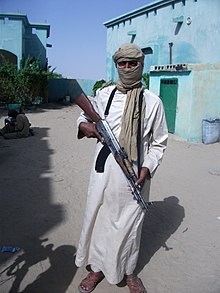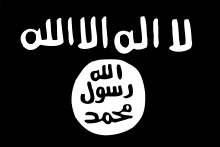Difference between revisions of "Al-Qaeda in the Islamic Maghreb"
Hunt.james (talk | contribs) m (→Composition) |
Hunt.james (talk | contribs) m |
||
| Line 45: | Line 45: | ||
==Notes== | ==Notes== | ||
*Portions of this page were excerpted from the [https://en.wikipedia.org/wiki/Al-Qaeda_in_the_Islamic_Maghreb Wikipedia page] for added realism. | *Portions of this page were excerpted from the [https://en.wikipedia.org/wiki/Al-Qaeda_in_the_Islamic_Maghreb Wikipedia page] for added realism. | ||
| + | |||
| + | [[Category:DATE]] | ||
| + | [[Category:Africa]] | ||
| + | [[Category:Non-State Actors]] | ||
| + | [[Category:Threat Actors]] | ||
Revision as of 22:20, 27 September 2017

Membership is mostly drawn from the Algerian and local Saharan communities (such as the Tuaregs and Berabiche tribal clans of Mali), as well as Moroccans from city suburbs of the North African country. The leadership are mainly Algerians. The group has also been suspected of having links with the Horn of Africa-based militant group Al-Shabaab.
AQIM has focused on kidnapping for ransom as a means of raising funds and is estimated to have raised more than $50 million in the last decade.
On 2 March 2017, the Sahara branch of AQIM merged with Ansar Dine and Al-Mourabitoun into Jama'at Nasr al-Islam wal Muslimin.
Contents
History

On 19 January 2009, the UK newspaper The Sun reported that there had been an outbreak of bubonic plague at an AQIM training camp in the Tizi Ouzou province in Algeria. According to The Sun, at least forty AQIM militiamen died from the disease. The surviving AQIM members from the training camp reportedly fled to other areas of Algeria hoping to escape infection.[25] The Washington Times, in an article based on a senior U.S. intelligence official source, claimed a day later that the incident was not related to bubonic plague, but was an accident involving either a biological or chemical agent.[26]
Al Qaeda in the Islamic Maghreb is one of the region's wealthiest, best-armed militant groups due to the payment of ransom demands by humanitarian organizations and Western governments. It is reported that 90 per cent of AQIM resources come from ransoms paid in return for the release of hostages. Oumar Ould Hamaha said:
The source of our financing is the Western countries. They are paying for jihad.
In December 2012, one of AQIM's top commanders, Mokhtar Belmokhtar, split off from AQIM and took his fighters with him, executing the In Amenas hostage crisis in Algeria weeks later, just after France launched Operation Serval in Mali. Belmokhtar later claimed he acted on behalf of Al Qaeda. In December 2015, Belmokhtar's splinter group, Al-Mourabitoun rejoined AQIM, according to audio statements released by both groups.
A top commander of AQIM, Abdelhamid Abou Zeid, was reported killed by French and Chadian forces in northern Mali on February 25, 2013. This was confirmed by AQIM in June 2013.
Although its operations in the region have been more practical than its northern component. Its operations in Amari, Ziwa, and northern Kujenga appear to be more focused on ridding the region of "Western impurities" than solely religious ideology. AQIM perceives all non-Islamist governments as illegitimate and, accordingly, seeks to replace the various governments in the countries in which AQIM operates. The group declared its intention to attack European, Amari, Ziwan, French, and American interests in the region.
Statements
Al Qaeda in the Islamic Maghreb operates a media outlet known as al-Andalus, which regularly releases propaganda videos showing AQIM operations, hostages, and statements from members.
According to London-based risk analysis firm Stirling Assynt, AQIM issued a call for vengeance against Beijing for mistreatment of its Muslim minority following the July 2009 Ürümqi riots.
AQIM voiced support for demonstrations against the Tunisian and Algerian Governments in a video released on 13 January 2011. Al Qaeda offered military aid and training to the demonstrators, calling on them to overthrow "the corrupt, criminal and tyrannical" regime, calling for "retaliation" against the Tunisian government, and also calling for the overthrow of Algerian president Abdelaziz Bouteflika. AQIM leader Abu Musab Abdul Wadud appeared in the video, calling for Islamic sharia law to be established in Tunisia. Al Qaeda has begun recruiting anti-government demonstrators, some of whom have previously fought against American forces in Iraq and Israeli forces in Gaza.
AQIM endorsed efforts in Libya to topple the regime of Colonel Muammar Gaddafi, though it remains unclear how many fighters in Libya are loyal to al-Qaeda. Gaddafi seized on the expression of support and help for the rebel movement to blame al-Qaeda for fomenting the uprising.
Composition
Structurally, AQIM in the region maintains its links to the Majlis al-Ayan (Council of Notables) and continues to leverage many of its parent organization’s technical and media capabilities, as well as receiving funding. There have been accusations by the Amari and Ziwa governments that Nyumba has provided material support to AQIM in exchange for a measure of immunity, but these have not been substantiated.
See also TC 7-100.3 Irregular Opposing Forces, Chapter 2: Insurgents
Tactics
While attacks are not common in the Amari, there have been a number of high-profile bombings in Mombasa and Arusha attributed to the group. They reportedly operate and stage in predominantly urban Muslim districts and universities.
AQIM has a history of collaboration with guerrilla, insurgent, and criminal groups throughout the region to spread their ideology and establish relationships. Activities with criminals are largely to raise funds, trafficking everything from arms to cigarettes. AQIM’s kidnapping for ransom campaigns have focused is estimated to have raised more than $30 million in the last decade. Activities with insurgent groups and militias are largely for capability-sharing.
Notes
- Portions of this page were excerpted from the Wikipedia page for added realism.

